The ways of funding of the new generation of news outlets such as the Bristol Cable, New Internationalist and the Guardian are changed. How do membership models allow editors to deepen their contents and provide sufficient funds to their desired reports?
Do you want to expose the information that governments, businesses and other powerful interest groups kept hidden from the public? Are you trying to fight for the independent voices of the Press?
Are you experiencing financial difficulties in this process? Are you eager to overcome these difficulties and fight for the public’s rights to knowledge?
There’s a group of people here, who comes from the market, not the state, not the charity, not the government. They have long been committed to the freedom of press and liberating values free of commercial or political interference. They are shaking up the local journalism.
“Media organizations have always strived to be independent by being kind of profitable entities. We’d love to be independently funded by members and not rely on grant funding. But, at the moment, grant funding is an essential part of our funding,” says Lucas Batt, the coordinator at Bristol Cable.
Bristol Cable, powered by over 2,000 members who all have a say and own an equal share in their media co-operative, is a grassroots community-led media cooperative in Bristol. It publishes a free quarterly magazine with a circulation of 30,000 copies to thousands of homes and hundreds of premises in Bristol.

As profitable innovations in Britain’s paid-for national newspaper market have been in short supply in recent years, the industry has been abuzz with stories of takeovers, consolidations and closures. For example, Reach, the most prolific aggregator, closed New Day, a women-focused newspaper, in 2017, just weeks after publication, or the news of a hostile bid by vulture hedge fund for Newsquest, a local newspaper publisher. Many of the local media organizations were massively consolidated and then run by hedge funds and big catalyst projects.
“The advertising money isn’t there anymore. Particularly when they trying to earn revenue by click bait and various kind of extractive forms of publishing with which doing value readers there’s a number of reasons. So, there’s basically a need for new ways of funding journalism,” said Lucas.
Bristol Cable’s current status is that 40% of their funding comes from current members. The rest comes from print ads, which are governed by Bristol Cable’s advertising charter and voted on by members. Similarly, in 2017, after the New Internationalist ran into serious financial problems, the magazine offered readers community shares to maintain its independence and financial stability.
“In 2017, we decided to change from being a work close cooperative to a cooperative society. The reason we did this was because it would allow for an injection of capital, which we hope will provide us with some money to invest and continue to be sustainable into the future,” says Yohann Koshy, the editor at New Internationalist.
New Internationalist is an independent publishing co-operative, which has around 80000 subscribers, becoming the largest cooperative in terms of the amount of members in the UK. Through community stock offerings, New Internationalists are planning to reinvent their subscription model with different types of members and introduce more options of monetization.
Readers can invest between £50 and £10,000 each in community shares in the New Internationalist. No matter how many shares they buy, each co-owner will have an equal right to vote on major company decisions, such as advertising policies or editorial content. Similarly, the members of Bristol cable also have a voice and an equal share in media co-operation.
Bristol cable is showing that the membership model can work for local news, but now they have to do more to convince more people why it’s worth it. From the crowd-funding campaign of the first printed newspaper in 2014, they had their first community members and now have more than 30,000 members. Their attitude has always been to talk to people and keep in line with things that people are interested in. They try to make sure they are keeping in touch with their members and know about their concern to serve them in a better way.
“Trust in journalism is fundamentally broken. As the distance away from readers grows, especially as they try to make money from clickbait and various forms of extraction. Combined with various incidents, such as Leveson’s investigation into phone hacking, it has eroded public trust in journalists and journalism. So, we need a new business model. We need to regain the trust of the audience,” said Lucas.
When Bristol Cable first started, there were about twenty people who would come, and they will make the decision. It was easy for people to come to a meeting and vote somethings immediately. But when they have over 2000 members, they have directors who are elected from the membership at an annual general meeting and they have formal power in the organization.
“As members, they have the organization, and they can express their opinions in various ways. And I think it’s the local communities which the newspaper was meant to serve are involvement and only have a real stake and that can’t be taken away by any entity. It’s a collaborative model that tries to get people to volunteer as members to donate to journalism, ” says Lucas.
The members in Bristol Cable are in over 600 locations throughout the city, from pop, coffee shops, doctor’s offices, community centers, libraries, churches, mosques, anywhere, wherever needed. In addition, they are distributing them door-to-door. So, they pay a small number of members to take Bristol cable to different parts of the city and deliver it to people’s doors.
In addition, Bristol cable holds a monthly general meeting to give people a chance to learn about their news, what people care about and what they should cover. Moreover, they take these meetings to poor parts of the city and listen to people whose voices are not normally heard . They are trying to tell a much better story about this diverse and complex city.

What they are doing is changing the nature of local journalism, giving its members a say in how publications are organized and managed. It expanded the concept of journalism by training its members to be its eyes and ears on the street.
“As a cooperative, we want our members to be part of the media we produce. We encourage them to get involved, to write stories, to give journalists clues. This can be done by playing a role in the media we produce, from writing stories to providing leads and volunteering,” says Lucas.
Each year, they run a free training course called the Media Lab, funded by the Centre for Investigative Journalism. It recruits 10-15 students a year, and there is no threshold for their qualifications. They do not need to have a journalist background. In this lab they can learn basic journalism skills and learn about media law and ethics.
The goal of this course is to develop the skills of community contributors who have the skills to connect with different communities in the city and to hear voices that are not often heard. Also, it’s a way to help their users to become more knowledgeable by simply understanding how media organizations work, how news is produced, and the overall media environment.
“We are in our spirit actions transparent, open, trying to be collaborative and involved people. We try to take as many faces from stories and published them as much as possible. Because we’ve had feedback that it’s important that people see people being part of this,” says Lucas.
However, although New Internationalist is also a co-op magazine, their members are not involved in the writing and other creative processes of the magazine. New Internationalist considers its members as stakeholders and more likely to involve their supporting members in democratic decision-making.
“Obviously we’re past the golden age of journalism, in terms of the way was funded. And we need to be thinking of alternative ways of funding the media, and particularly going after Facebook and google, the large with oligopoly of deeply unaccountable centralized capital which is stealing revenue from traditional newspapers and magazines,” says Yohann.
At that time, the entire magazine industry is suffering from the impact of the Internet and social media. News organizations around the world are looking for answers to this challenge. Their websites are being read more than ever, but there are fewer ways to pay for them. Month by month, more and more news organizations start charging.
Unlike many publishers who have opted for a paywall, the Guardian has opted for a unique membership model. According to Grzegorz Piechota, who is a former media executive with more than 20 years of industry experience, at the end of 2018, the guardian’s membership model — with 570,000 members and subscribers combined — had about half as many customers as the Times and the post’s paywall, but it is growing faster than UK peers such as the Times of London.
The guardian calls its model Membership. Robbie Baxter writes in Membership Economy that permanent deals encourage companies to focus on the quality of their relationships with customers and provide the best long-term experience.
So, in 2013, the Guardian opened Guardian Witness, further enhancing their two-way dialogue with members and opening their website in an unprecedented way. It allows users from around the world to share video, pictures and text directly to the guardian’s editorial team.
“at the guardian we have a long history of engaging our readers in our journalism,” says Joanna Geary, the guardian’s social and community editor. Although five years later, Guardian Witness closed, Guardian does not give up the exploration and experiment of membership system.
In order to achieve the growth, the guardian to expand its product line from membership for fans to the applications of heavy users subscribe. It launched a subscription service for mobile apps in 2018 and introduced a new super-user layer. Grzegorz’s research shows that the guardian’s choice of a unique membership model has helped it fulfil its mission, freeing it from the pressure of breaking even through advertising alone.
In the face of the same digital shock, New Internationalist went public the other way in March 2017, not on the stock exchange, but in a community share issue that raised more than £700,000. That helped them go from 18 workers’ cooperatives to more than 3,600 in 42 countries. Now they have an international community of subscribers and readers in 80 countries.
In the months following the stock offering, New Internationalist used the money to launch their first partnership with Myriad, a book publisher with a very similar perspective to New Internationalist, bringing considerable book publishing expertise and an exciting array of publications to New Internationalist. Then they teamed up with TCO London, a design consultant, to do a bold experiment for the print magazine — offering a deeper, reflective style of journalism more suited to what is emerging.
“It’s tough in a way, because our model works because we are legacy publication with a forty-year history,” says Yohann. “But if you’re an editor, starting a publication from scratch, I think you just really need to look at the media ecosystem, decide yourself what is missing, and then make the case that you’ll be able to provide that missing link.”
Bristol cables don’t have a lot of history, but they are serving Bristol with print communications. Their models and methods are likely to be replicated in other UK cities and abroad.
“If you’re starting with nothing like we did, then you need to look at how you’re building relationships with communities, keep people in those communities and meeting as many people as you can,” says Lucas. “Firstly, to understand what their needs are, so that they can hear about the project and can help shape the project so that you can create a membership model of funding model that they’ve been invited to”

